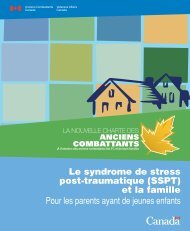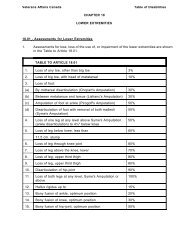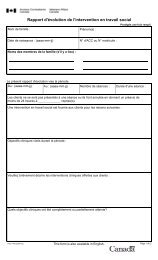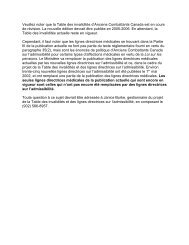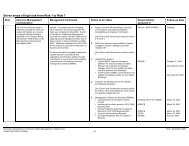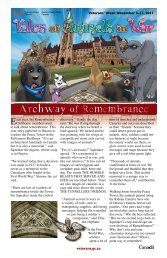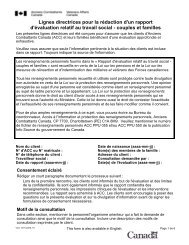Chapter 9 HEARING LOSS and EAR IMPAIRMENT
Chapter 9 HEARING LOSS and EAR IMPAIRMENT
Chapter 9 HEARING LOSS and EAR IMPAIRMENT
- No tags were found...
You also want an ePaper? Increase the reach of your titles
YUMPU automatically turns print PDFs into web optimized ePapers that Google loves.
| Table of Disabilities - <strong>Chapter</strong> 9 - Hearing Loss <strong>and</strong> Ear Impairment Modified November 2007<strong>Chapter</strong> 9<strong>H<strong>EAR</strong>ING</strong> <strong>LOSS</strong> <strong>and</strong> <strong>EAR</strong> <strong>IMPAIRMENT</strong>IntroductionThis chapter provides criteria for assessing permanent impairment from entitledconditions of the ears (hearing loss, otitis media/otitis externa (otalgia/otorrhea), tinnitus<strong>and</strong>/or vertigo/disequilibrium).The table for rating vertigo/disequilibrium from central <strong>and</strong> peripheral causes iscontained within this chapter.Impairment from malignant ear conditions is rated within <strong>Chapter</strong> 18, MalignantImpairment. Follow the steps contained within the Malignant Impairment chapter.Rating TablesThis chapter contains one “Loss of Function” table <strong>and</strong> three “Other Impairment” tableswhich may be used to rate entitled hearing loss <strong>and</strong> ear conditions.The tables within this chapter are:Table 9.1 Loss of Function - Hearing Loss This table is used to rate impairment fromhearing loss.Table 9.2Other Impairment - Otitis Media/OtitisExterna (Otalgia/Otorrhea) <strong>and</strong> EustachianTube Dysfunction.This table is used to rate impairment fromotitis media/otitis externa(otalgia/otorrhea) <strong>and</strong> eustachian tubedysfunction.Table 9.3 Other Impairment - Tinnitus This table is used to rate impairment fromtinnitus.Table 9.4 Other Impairment - Vertigo/Disequilibrium This table is used to rate impairment fromvertigo/disequilibrium.Veterans Affairs Canada Page 1
| Table of Disabilities - <strong>Chapter</strong> 9 - Hearing Loss <strong>and</strong> Ear Impairment Modified November 2007Loss of Function - Hearing LossTable 9.1 is used to rate impairment from hearing loss.Hearing loss is generally entitled as a bilateral condition, with hearing in both earscontributing to a functional loss. Only one rating may be selected from this table forbilateral hearing loss. Occasionally, a rating will be required for hearing loss in one ear(monaural) only.There are three types of hearing loss (e.g. conductive, sensorineural or mixed). Totalhearing impairment, regardless of the cause, is included in the impairment criteria. Airconduction decibel values are used in the calculation of the decibel sum hearing loss(DSHL). When there is a significant difference between masked <strong>and</strong> unmasked airconduction values, the masked values should be used in assessing the impairment.For determination of assessment of a hearing loss one must calculate the DSHL. TheDSHL is calculated over the following four frequencies: 500 htz, 1000 htz, 2000 htz <strong>and</strong>3000 htz. A DSHL is calculated for each entitled ear. The DSHL is obtained by addingthe decibel loss in hearing at the four mentioned frequencies in each entitled ear. Anon-entitled ear is considered to have a DSHL of 95. The DSHL is used in conjunction| with Table 9.1 to rate the extent of hearing loss.When entitled hearing loss conditions result in permanent impairment of other organsystems, a consequential entitlement decision is required. If awarded, the resultingimpairment of that organ system(s) will be rated using the applicable body systemspecific table(s).Other Impairment - Otitis Media/Otitis Externa (Otalgia/Otorrhea) <strong>and</strong> EustachianTube DysfunctionTable 9.2 is used to rate impairment from otitis media, otitis externa (otalgia/otorrhea)<strong>and</strong> eustachian tube dysfunction. Only one rating may be selected for each entitledcondition. If more than one rating is applicable for an entitled condition, the ratings arecompared <strong>and</strong> the highest selected.When entitled otitis media/otitis externa (otalgia/otorrhea) <strong>and</strong> eustachian tubedysfunction conditions result in permanent impairment of other organ systems, aconsequential entitlement decision is required. If awarded, the resulting impairment ofthat organ system(s) will be rated using the applicable body system specific table(s).If non-entitled conditions or conditions rated within another chapter/table of the Table ofDisabilities are contributing to the overall impairment, then the Partially ContributingTable (PCT) must be applied to arrive at the rating which is due to the entitledcondition(s) rated within this table.Veterans Affairs Canada Page 2
| Table of Disabilities - <strong>Chapter</strong> 9 - Hearing Loss <strong>and</strong> Ear Impairment Modified November 2007Other Impairment - TinnitusTable 9.3 is used to rate impairment from tinnitus. Only one rating may be selected. Ifmore than one rating is applicable, the ratings are compared <strong>and</strong> the highest selected.When entitled tinnitus conditions result in permanent impairment of other organsystems, a consequential entitlement decision is required. If awarded, the resultingimpairment of that organ system(s) will be rated using the applicable body systemspecific table(s).If non-entitled conditions or conditions rated within another chapter/table of the Table ofDisabilities are contributing to the overall impairment, then the Partially ContributingTable (PCT) must be applied to arrive at the rating which is due to the entitledcondition(s) rated within this table.Other Impairment - Vertigo/DisequilibriumTable 9.4 is used to rate impairment from vertigo <strong>and</strong> disequilibrium conditions. Onlyone rating may be selected. If more than one rating is applicable, the ratings arecompared <strong>and</strong> the highest selected.When entitled vertigo/disequilibrium conditions result in permanent impairment of otherorgan systems, a consequential entitlement decision is required. If awarded, theresulting impairment of that organ system(s) will be rated using the applicable bodysystem specific table(s).If non-entitled conditions or conditions rated within another chapter/table of the Table ofDisabilities are contributing to the overall impairment, then the Partially ContributingTable (PCT) must be applied to arrive at the rating which is due to the entitledcondition(s) rated within this table.Veterans Affairs Canada Page 3
| Table of Disabilities - <strong>Chapter</strong> 9 - Hearing Loss <strong>and</strong> Ear Impairment Modified November 2007Table 9.1 - Loss of Function - Hearing LossOnly one rating may be given from Table 9.1.To use this Table, calculate the decibel sum hearing loss (DSHL) over four frequenciesfor each ear; 500, 1000, 2000, <strong>and</strong> 3000 htz. Use the vertical axis to plot the DSHLvalue for the worse ear, <strong>and</strong> the horizontal axis to plot the DSHL value for the betterear. The point of intersection is the impairment value. If only one ear is entitled theDSHL in the non-entitled ear is always considered to be 95.If the rating determined above is “0" but there is a decibel loss of at least 50 decibels at4000 htz in both ears, then a hearing loss rating of “1" is assigned.Veterans Affairs Canada Page 4
Table 9.1 - Hearing Loss Impairment TableWorse Ear| 95 0| 100 3 4| 105 4 4 5110 4 4 5 5115 4 4 5 5 6120 4 4 5 5 6 7125 4 5 5 6 6 7 7130 4 5 5 6 6 7 7 8135 4 5 5 6 6 7 7 8 9140 4 5 5 6 6 7 8 8 9 9145 4 5 5 6 7 7 8 8 9 9 10150 5 5 6 6 7 7 8 8 9 9 10 11155 5 5 6 6 7 7 8 8 9 10 10 11 11160 5 5 6 6 7 7 8 9 9 10 10 11 11 15165 5 5 6 6 7 8 8 9 9 10 10 11 11 15 15170 5 5 6 7 7 8 8 9 9 10 10 11 15 15 16 16175 5 6 6 7 7 8 8 9 9 10 11 11 15 15 16 16 17180 5 6 6 7 7 8 8 9 10 10 11 11 15 15 16 16 17 17185 5 6 6 7 7 8 9 9 10 10 11 11 15 15 16 16 17 18 18190 5 6 6 7 8 8 9 9 10 10 11 11 15 15 16 17 17 18 18 19195 5 6 7 7 8 8 9 9 10 10 11 15 15 16 16 17 17 18 18 19 19200 6 6 7 7 8 8 9 9 10 11 11 15 15 16 16 17 17 18 18 19 20 20205 6 6 7 7 8 8 9 10 10 11 11 15 15 16 16 17 17 18 19 19 20 20 21210 6 6 7 7 8 9 9 10 10 11 11 15 15 16 16 17 18 18 19 19 20 20 21 21215 6 6 7 8 8 9 9 10 10 11 11 15 15 16 17 17 18 18 19 19 20 20 21 21 22220 6 7 7 8 8 9 9 10 10 11 15 15 16 16 17 17 18 18 19 19 20 21 21 22 22 23225 6 7 7 8 8 9 9 10 11 11 15 15 16 16 17 17 18 18 19 20 20 21 21 22 22 23 23230 6 7 7 8 8 9 10 10 11 11 15 15 16 16 17 17 18 19 19 20 20 21 21 22 22 23 23 24235 6 7 7 8 9 9 10 10 11 11 15 15 16 16 17 18 18 19 19 20 20 21 21 22 22 23 24 24 25240 6 7 8 8 9 9 10 10 11 11 15 15 16 17 17 18 18 19 19 20 20 21 21 22 23 23 24 24 25 25245 7 7 8 8 9 9 10 10 11 15 15 16 16 17 17 18 18 19 19 20 21 21 22 22 23 23 24 24 25 25 26250 7 7 8 8 9 9 10 11 11 15 15 16 16 17 17 18 18 19 20 20 21 21 22 22 23 23 24 24 25 26 26 27255 7 7 8 8 9 10 10 11 11 15 15 16 16 17 17 18 19 19 20 20 21 21 22 22 23 23 24 25 25 26 26 27 27260 7 7 8 9 9 10 10 11 11 15 15 16 16 17 18 18 19 19 20 20 21 21 22 22 23 24 24 25 25 26 26 27 27 28265 7 8 8 9 9 10 10 11 11 15 15 16 17 17 18 18 19 19 20 20 21 21 22 23 23 24 24 25 25 26 26 27 28 28 29270 7 8 8 9 9 10 10 11 15 15 16 16 17 17 18 18 19 19 20 21 21 22 22 23 23 24 24 25 25 26 27 27 28 28 29 29275 7 8 8 9 9 10 11 11 15 15 16 16 17 17 18 18 19 20 20 21 21 22 22 23 23 24 24 25 26 26 27 27 28 28 29 29 30280 7 8 8 9 10 10 11 11 15 15 16 16 17 17 18 19 19 20 20 21 21 22 22 23 23 24 25 25 26 26 27 27 28 28 29 29 30 31285 7 8 9 9 10 10 11 11 15 15 16 16 17 18 18 19 19 20 20 21 21 22 22 23 24 24 25 25 26 26 27 27 28 28 29 30 30 31 31To use this Table, calculate the decibel sum hearing loss (DSHL) overfour frequencies for each ear; 500, 1000, 2000, <strong>and</strong> 3000 htz. Usethe vertical axis to plot the DSHL value for the worse ear, <strong>and</strong> thehorizontal axis to plot the DSHL value for the better ear. The point ofintersection is the impairment value. If only one ear is entitled theDSHL in the non-entitled ear is always considered to be 95.If the rating determined above is “0" but there is a decibel loss of atleast 50 decibels at 4000 htz in both ears, then a hearing loss rating of“1" is assigned.290 8 8 9 9 10 10 11 11 15 15 16 17 17 18 18 19 19 20 20 21 21 22 23 23 24 24 25 25 26 26 27 28 28 29 29 30 30 31 31 32295 8 8 9 9 10 10 11 15 15 16 16 17 17 18 18 19 19 20 21 21 22 22 23 23 24 24 25 25 26 27 27 28 28 29 29 30 30 31 31 32 33300 8 8 9 9 10 11 11 15 15 16 16 17 17 18 18 19 20 20 21 21 22 22 23 23 24 24 25 26 26 27 27 28 28 29 29 30 30 31 32 32 33 33305 8 8 9 10 10 11 11 15 15 16 16 17 17 18 19 19 20 20 21 21 22 22 23 23 24 25 25 26 26 27 27 28 28 29 29 30 31 31 32 32 33 33 34310 8 9 9 10 10 11 11 15 15 16 16 17 18 18 19 19 20 20 21 21 22 22 23 24 24 25 25 26 26 27 27 28 28 29 30 30 31 31 32 32 33 33 34 35315 8 9 9 10 10 11 11 15 15 16 17 17 18 18 19 19 20 20 21 21 22 23 23 24 24 25 25 26 26 27 28 28 29 29 30 30 31 31 32 32 33 34 34 35 35320 8 9 9 10 10 11 15 15 16 16 17 17 18 18 19 19 20 21 21 22 22 23 23 24 24 25 25 26 27 27 28 28 29 29 30 30 31 31 32 33 33 34 34 35 35 36325 8 9 9 10 11 11 15 15 16 16 17 17 18 18 19 20 20 21 21 22 22 23 23 24 24 25 26 26 27 27 28 28 29 29 30 30 31 32 32 33 33 34 34 35 35 36 36330 8 9 10 10 11 11 15 15 16 16 17 17 18 19 19 20 20 21 21 22 22 23 23 24 25 25 26 26 27 27 28 28 29 29 30 31 31 32 32 33 33 34 34 35 35 36 37 37335 9 9 10 10 11 11 15 15 16 16 17 18 18 19 19 20 20 21 21 22 22 23 24 24 25 25 26 26 27 27 28 28 29 30 30 31 31 32 32 33 33 34 35 35 36 36 37 37 38340 9 9 10 10 11 11 15 15 16 17 17 18 18 19 19 20 20 21 21 22 23 23 24 24 25 25 26 26 27 28 28 29 29 30 30 31 31 32 32 33 34 34 35 35 36 36 37 37 38 38345 9 9 10 10 11 15 15 16 16 17 17 18 18 19 19 20 21 21 22 22 23 23 24 24 25 25 26 27 27 28 28 29 29 30 30 31 31 32 33 33 34 34 35 35 36 36 37 37 38 39 39350 9 9 10 11 11 15 15 16 16 17 17 18 18 19 20 20 21 21 22 22 23 23 24 24 25 26 26 27 27 28 28 29 29 30 30 31 32 32 33 33 34 34 35 35 36 36 37 38 38 39 39 40355 9 9 10 11 11 15 15 16 16 17 17 18 18 19 20 20 21 21 22 22 23 23 24 24 25 26 26 27 27 28 28 29 29 30 31 31 32 32 33 33 34 34 35 35 36 37 37 38 38 39 39 40 4095 100 105 110 115 120 125 130 135 140 145 150 155 160 165 170 175 180 185 190 195 200 205 210 215 220 225 230 235 240 245 250 255 260 265 270 275 280 285 290 295 300 305 310 315 320 325 330 335 340 345 350 355Better Ear
| Table of Disabilities - <strong>Chapter</strong> 9 - Hearing Loss <strong>and</strong> Ear Impairment Modified November 2007Table 9.2 - Other Impairment - Otitis Media/Otitis Externa (Otalgia/Otorrhea) <strong>and</strong>Eustachian Tube DysfunctionOnly one rating may be given from Table 9.2 for each entitled condition. If more thanone rating is applicable for an entitled condition, the ratings are compared <strong>and</strong> thehighest selected.Each bullet (•) represents one criterion. In order for a rating to be established forTable 9.2, only one criterion must be met at a level of impairment for that rating to beselected.Table 9.2 - Other Impairment - Otitis Media/Otitis Externa (Otalgia/Otorrhea) <strong>and</strong> Eustachian TubeDysfunctionRatingCriteriaNil • One episode of otitis media/otitis externa (otalgia/otorrhea) treated successfullywith no recurrence; or• One episode of eustachian tube dysfunction treated successfully with norecurrence.Two • Intermittent symptoms of otitis media/otitis externa (otalgia/otorrhea) requiringperiodic treatment; or• Intermittent symptoms of eustachian tube dysfunction requiring periodictreatment.Five • Continuous symptoms of otitis media/otitis externa (otalgia/otorrhea) requiringongoing treatment; or• Continuous symptoms of eustachian tube dysfunction requiring ongoingtreatment.Table 9.3 - Other Impairment - TinnitusOnly one rating may be given from Table 9.3. If more than one rating is applicable, theratings are compared <strong>and</strong> the highest selected.Each bullet (•) represents one criterion. In order for a rating to be established forTable 9.3, all criteria designated beside each bullet (•) must be met.Veterans Affairs Canada Page 6
| Table of Disabilities - <strong>Chapter</strong> 9 - Hearing Loss <strong>and</strong> Ear Impairment Modified November 2007Table 9.3 - Other Impairment - TinnitusRatingCriteriaNil • Occasional tinnitus, present less than once a week affecting one or both ears.One • Occasional tinnitus, present at least once a week affecting one or both ears.Three • Intermittent tinnitus, present daily, but not all day long, affecting one or bothears.Five• Continuous tinnitus, present all day <strong>and</strong> all night, every day, affecting one orboth ears, but does not require use of prescribed masking devices or otherprescribed modalities but may use non-prescribed devices such as radio, etc.| Ten• Continuous tinnitus, present all day <strong>and</strong> all night, every day, affecting one orboth ears, <strong>and</strong> has been prescribed a masking device <strong>and</strong>/or other prescribed| modalities (i.e., prescribed meds for tinnitus) . W hen prescribed modalities e.g.,| meds are prescribed, supporting documentation from the health care| professional should be provided)Table 9.4 - Other Impairment - Vertigo/DisequilibriumOnly one rating may be given from Table 9.4. If more than one rating is applicable, theratings are compared <strong>and</strong> the highest selected.Each bullet (•) represents one criterion. In order for a rating to be established forTable 9.4, all criteria designated beside each bullet (•) must be met.Table 9.4 - Other Impairment - Vertigo/DisequilibriumRatingCriteriaNil • Past history of vertigo/disequilibrium, but no current symptoms.FiveTen• Intermittent symptoms of vertigo/disequilibrium with or without objective findingssuch as nystagmus <strong>and</strong> ataxia; <strong>and</strong>• Activities of daily living are performed without assistance.• Symptoms of vertigo/disequilibrium are present on a daily basis with supportingobjective findings such as nystagmus <strong>and</strong> ataxia; <strong>and</strong>• Usual activities of daily living are performed without assistance although activitiesrequiring balance <strong>and</strong> precision, such as bike riding, climbing ladders, etc., cannotbe performed.Veterans Affairs Canada Page 7
| Table of Disabilities - <strong>Chapter</strong> 9 - Hearing Loss <strong>and</strong> Ear Impairment Modified November 2007RatingThirtySixtyCriteria• Symptoms of vertigo/disequilibrium are present on a daily basis with supportingobjective findings such as nystagmus <strong>and</strong> ataxia; <strong>and</strong>• Activities of daily living cannot be performed without assistance, but remains ableto walk short distances <strong>and</strong> perform simple self care activities such as eating,washing face <strong>and</strong> h<strong>and</strong>s, <strong>and</strong> simple household duties such as dusting, sweepingfloor.• Symptoms of vertigo/disequilibrium are present on a daily basis with supportingobjective findings such as nystagmus <strong>and</strong> ataxia; <strong>and</strong>• Activities of daily living such as washing face, brushing teeth, combing hair cannotbe performed without assistance. Can no longer walk even short distanceswithout assistance.Eighty-five • Symptoms of vertigo/disequilibrium are present on a daily basis with supportingobjective findings such as nystagmus <strong>and</strong> ataxia; <strong>and</strong>• Activities of daily living must be performed by caregiver; <strong>and</strong>• Member/Veteran/Client is confined to home <strong>and</strong> premises.Veterans Affairs Canada Page 8
| Table of Disabilities - <strong>Chapter</strong> 9 - Hearing Loss <strong>and</strong> Ear Impairment Modified November 2007Steps to Determine Hearing Loss <strong>and</strong> Ear Impairment AssessmentStep 1:Step 2:Step 3:Determine total Decibel Sum Hearing Loss (DSHL) for each ear.Determine the rating from Table 9.1(Loss of Function - Hearing Loss).Determine the Quality of Life rating.Step 4: Add the ratings at Step 2 <strong>and</strong> Step 3.This is the Disability Assessment for hearing loss.Step 5:Step 6:Step 7:Determine the rating from Table 9.2 (Other Impairment - Otitis Media/OtitisExterna (Otalgia/Otorrhea) <strong>and</strong> Eustachian Tube Dysfunction).Does the Partially Contributing Table apply? If yes, then apply to rating atStep 6.Determine the Quality of Life rating.Step 8: Add the ratings at Step 7 <strong>and</strong> Step 8.This is the Disability Assessment forotitis media/otitis externa (otalgia/otorrhea) <strong>and</strong> eustachian tube dysfunction.Note:Step 9:Step 10:Step 11:If more than one entitled condition requires assessment from Table9.2, Steps 6 - 10 must be repeated.Determine the rating from Table 9.3 (Other Impairment - Tinnitus).Does the Partially Contributing Table apply? If yes, then apply to rating atStep 11.Determine the Quality of Life rating.Step 12: Add the ratings at Step 12 <strong>and</strong> Step 13.Veterans Affairs Canada Page 9
| Table of Disabilities - <strong>Chapter</strong> 9 - Hearing Loss <strong>and</strong> Ear Impairment Modified November 2007This is the Disability Assessment for tinnitus.Step 13: Determine the rating from Table 9.4 (Other Impairment -Vertigo/Disequilibrium).Step 14:Step 15:Does the Partially Contributing Table apply? If yes, then apply to rating atStep 16.Determine the Quality of Life rating.Step 16: Add the ratings at Step 17 <strong>and</strong> Step 18.This is the Disability Assessment for vertigo/disequilibrium.Veterans Affairs Canada Page 10




